

: Admin : 2022-05-23
Monitoring of intracranial pressure, often known as ICP monitoring, involves inserting a pressure monitor into the child's skull in order to measure the pressure within the child's head.
What steps are taken prior to the insertion of the ICP monitor?
If this is a procedure that was planned for your child, you should have gotten information on how to best prepare your child for the treatment before it took place. On the day of the operation, the surgeon will provide you with further details on the treatment, address any concerns you may have, and request that you sign a consent form in order to grant your approval for the operation. You will be visited by a second physician who will talk to you about the anesthetic.
Please make sure that the physicians are aware of any and all medical issues, including any allergies, that your child may have. Additionally, doctors ask that you bring in any medications that your child is now taking.
What exactly is involved in ICP monitoring?
During a brief process that takes place while your kid is under a general anesthetic, the ICP monitoring device, also known as the ICP bolt, will be implanted. After your child has been brought back to the ward, the nurses will conduct a careful observation of him or her. Due to the fact that it could take some time for the pressure within the head to return to its normal state following the process, the ICP bolt might not be linked to the computer right once. Readings of the pressure will be taken at regular intervals once the ICP bolt has been linked to the computer so that the pressure may be accurately measured.
If your child does something that causes a change in the pressure that is occurring within his or her skull, you can see a change in the reading on the pressure gauge. These may include moving about, shifting position in bed, coughing or sneezing, throwing up, sobbing, or moving around in general. You will also see that the reading for the pressure varies depending on whether or not your child is awake. This is something that you should be aware of. During the time that the ICP monitoring is taking place, the nurse caring for your child will routinely assess the amount of wakefulness that they are experiencing. In order to get a full picture, he or she will note the blood pressure measurements as well as the activities that your child was participating in at the time.
Doctors strongly recommend that while ICP monitoring on the ward (anywhere other than the critical care unit), your kid engage in as much of their typical activities as is safely feasible. This ensures that the ICP monitoring accurately represents the pressure within your child's skull as they are going about their typical day-to-day activities. The nurse who is caring for your child will tighten the ICP bolt to limit the risk of it being knocked or dragged out of place, but you may also assist by keeping your child distracted with toys and diversions.
Are there any risks?
ICP monitoring is believed to be a risk-free practice that provides helpful information that may be used to understand the status of your kid and to plan any therapy that may be necessary. On the other hand, as is the case with any surgery, there are a few possible issues that you should be aware of. Any surgery that involves breaking the skin carries with it the inherent danger of bleeding as well as infection. Regular checks will be performed by the nurses on the area where the ICP bolt was installed.
Additionally, there is a remote possibility that some cerebrospinal fluid may escape from the puncture site in very minute quantities. Again, this will be monitored on a regular basis, but if your kid begins to complain of headaches, please let the nurses know right away. In the vast majority of instances, this will be attributable to the surgery itself rather than any CSF leaking, and it may be managed with medications that alleviate discomfort. If not enough information has been captured, there may be times when the monitoring has to continue for a few more days.
What happens afterwards?
Monitoring of your child's intracranial pressure will be terminated as soon as there is sufficient information available concerning their condition. On the ward, the ICP bolt will be withdrawn after your kid has been given medications to reduce any discomfort caused by the procedure. There is a stitch that goes around the ICP bolt, and it is going to be pulled tight to seal the wound. This will assist the wound in healing more effectively.
Your kid's nurse will go through wound care instructions with you before you leave the hospital, as well as when your child may return to their regularly scheduled activities and school. After a week has passed, the stitch will need to be removed by your general practitioner (GP), at which point you will be able to shampoo your child's hair.
When will we get the results?
After the readings have been analyzed, the neurosurgeon will consult with you about the findings and determine any necessary treatment at that time.
You need to get in touch with the ward:
icp icp monitor Monitoring of intracranial pressure
No Comments